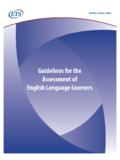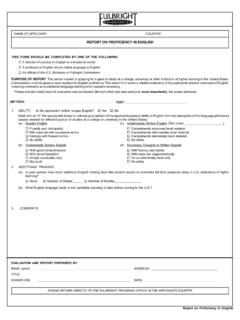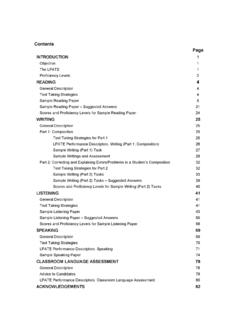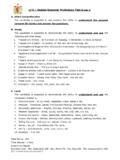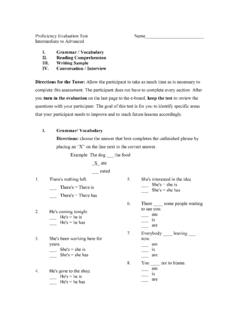Transcription of English - VDOE
1 English : Strategies for Teaching Limited English Proficient (LEP) Students A Supplemental Resource Guide to the K-12 English Standards of Learning Enhanced Scope and Sequence Virginia Department of Education Division of Instruction January 2006 2 Copyright 2006 by the Virginia Department of Education Box 2120 Richmond, Virginia 23218-2120 All rights reserved. Reproduction of materials contained herein for instructional purposes in Virginia classrooms is permitted. Acting Superintendent of Public Instruction Patricia I. Wright, Assistant Superintendent for Instruction Linda M. Wallinger, Office of Program Administration and Accountability Roberta Schlicher, Director Val Gooss, ESL Coordinator Jennifer Sherry, ESL Specialist Acknowledgements Ann A. Kennedy, , Reading Specialist, Arlington Public Schools NOTICE TO THE READER In accordance with the requirements of the Civil Rights Act and other federal and state laws and regulations, this document has been reviewed to ensure that it does not reflect stereotypes based on sex, race, or national origin.
2 The Virginia Department of Education does not unlawfully discriminate on the basis of sex, race, age, color, religion, handicapping conditions, or national origin in employment or in its educational programs and activities. The content contained in this document is supported in whole or in part by the Department of Education. However, the opinions expressed herein do not necessarily reflect the position or policy of the Department of Education, and no official endorsement by the Department of Education should be inferred. Virginia Department of Education January 2006 3 Table of Contents I. 4 II. Second Language Acquisition 5 III. Misconceptions about Language 10 IV. Cultural Differences in the 13 V. Cultural Differences Related to Content Areas .. 17 VI. Strategies for Teaching Language Arts and Content Areas to LEP 19 VII. Informal Assessment for LEP Students .. 29 VIII.
3 Assessment Accommodations for LEP Students .. 31 IX. LEP Resources .. 35 X. Resources for Instructional Strategies .. 37 XI. 39 Virginia Department of Education January 2006 4I. Purpose This document serves as a supplement to the K-12 English Standards of Learning Enhanced Scope and Sequence, which helps teachers align their classroom instruction with the revised English Standards of Learning that were adopted by the Virginia Board of Education in November 2002. The purpose of this document is to provide language arts and content teachers with a brief overview of second language acquisition theory and suggest effective strategies for differentiating instruction for limited English proficient (LEP) students. Differentiated instruction is particularly effective in helping LEP students acquire English and meet academic achievement standards in content classes as it recognizes students varying background knowledge and experiences, language, culture, learning styles, and readiness.
4 Just as the school-aged LEP population throughout the United States has experienced significant growth over the past decades, so has the school-aged LEP population in some areas of Virginia. Since 1992 the number of LEP students in Virginia public schools has more than tripled, resulting in LEP students residing in all eight regions of the state, speaking over 118 different languages, and representing over 72 countries. In addition to an increased number of LEP students, school divisions have also responded to the federal requirements under the reauthorization of Public Law 107-110, the No Child Left Behind Act of 2001 (NCLB). One of the performance goals of NCLB requires LEP students to become proficient in English while reaching high academic achievement standards in reading/language arts and mathematics. NCLB also requires that LEP students participate in annual academic assessments in reading/language arts and mathematics, which are used to determine adequate yearly progress for schools, school divisions, and the state [Public Law 107-110, Sec.]
5 1111(b)(3)(A)]. The rapid growth of the LEP student population in Virginia coupled with the increased federal accountability requirements under NCLB have resulted in an increased need for language arts and content teachers to understand the unique needs of LEP students in their classes. The strategies described in this document will provide these teachers with effective practices for incorporating their particular content Standards of Learning and the English Language Proficiency (ELP) Standards of Learning in daily instruction. The ELP Standards of Learning can be accessed through the Virginia Department of Education Web site at the following link: Incorporation of these strategies will increase the likelihood of LEP student success in content classrooms. Virginia Department of Education January 2006 5II. Second Language Acquisition Research According to second language researchers, acquiring a second language is a difficult and complex process (Collier, 1995; Krashen & Terrell, 1983).
6 In the early stages of learning a second language, learners pass through developmental stages similar to those when learning a first language. Early on, LEP students may err in their use of grammar or vocabulary, just as first language learners do (Collier, 1995; Krashen & Terrell, 1983). Although the process of second language acquisition varies with each student, depending on various factors, it is important to acknowledge that all LEP students go through general developmental stages (Collier, 1995; Krashen & Terrell, 1983). With increased exposure to the English language, LEP students progress from acquiring social language to the more complex academic language (Collier, 1995). Social language is considered conversational, contextualized language and can be developed within two to three years. Academic language is defined as the combination of cognitive skills and content knowledge necessary for successful academic performance at secondary and university levels (Thomas & Collier, 2002).
7 Collier (1995) indicates that it can take a minimum of seven to ten years to achieve academic proficiency if all of the schooling takes place in the second language. The chart below summarizes general behaviors of LEP students at each stage of language acquisition according to Krashen (1982). Stage of Language Acquisition General Behaviors of LEP Students Silent/Receptive Stage 10 hours to 6 months 500 receptive words point to objects, act, nod, or use gestures say yes or no speak hesitantly Early Production Stage 6 months to 1 year 1000 receptive/active words produce one- or two-word phrases use short repetitive language focus on key words and context clues Speech Emergence Stage 1-2 years 3000 active words engage in basic dialogue respond using simple sentences Intermediate Fluency Stage 2-3 years 6000 active words use complex sentences state opinions and original thoughts ask questions Advanced Fluency Stage 5-7 years (Krashen, 1982) 7-10 years (Collier, 1995)
8 Content-area vocabulary converse fluently understand grade-level classroom activities argue and defend academic points read grade-level textbooks write organized and fluent essays Krashen s (1982) five stages of language acquisition described above are a general framework for understanding how LEP students progress; however, language Virginia Department of Education January 2006 6learning is an on-going, fluid process that differs for every student. Students may move back and forth between stages, depending on the academic demands of a lesson and the amount of participation required. For example, a LEP student may be functioning at the intermediate fluency stage when performing routine tasks or accessing previously learned skills. However, when the academic content is new and the student lacks adequate background knowledge or experiences, the student may regress to the prior stage (early production).
9 For language acquisition to occur, students must (1) receive understandable and meaningful messages that are a little beyond their comprehension level; and (2) learn in an environment where there is little or no anxiety (Collier, 1995; Krashen, 1981, 1982; Vygotsky, 1978). Recognizing these two principles can assist teachers in creating a natural language learning environment in their classrooms. Outlined below are five key elements of an effective language learning environment. Use of these strategies can assist all students in accessing the content material. 1) Comprehensible input Teachers can make their language more comprehensible by modifying their speech by avoiding colloquialisms and speaking clearly, adjusting teaching materials, adding redundancy and context, and scaffolding information within lessons. 2) Reduced anxiety level A student s emotions play a pivotal role in assisting or interfering with learning a second language.
10 Teachers can assist students by creating a comfortable environment that encourages participation and risk-taking without fear of feeling embarrassed or foolish (Collier, 1995; Krashen, 1981; Krashen & Terrell, 1983). 3) Contextual clues Visual support makes language more comprehensible. For example, a grammar lesson using manipulatives may be more understandable than an explanation of the grammar rule. Even social language is more comprehensible when context is added. For example, understanding a face-to-face conversation in which facial expressions and gestures are used is easier than understanding a telephone conversation when context clues are non-existent (Cummins, 1981). 4) Verbal interaction Students need opportunities to work together to solve problems and use English for meaningful purposes. They need to give and receive information and complete authentic tasks. 5) Active participation Lessons that encourage active involvement motivate LEP students, engage them in the learning process, and help them remember content more easily.










